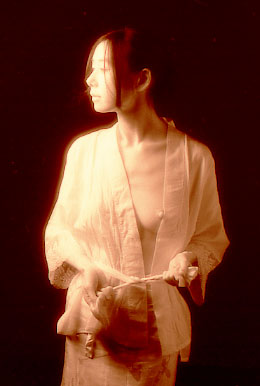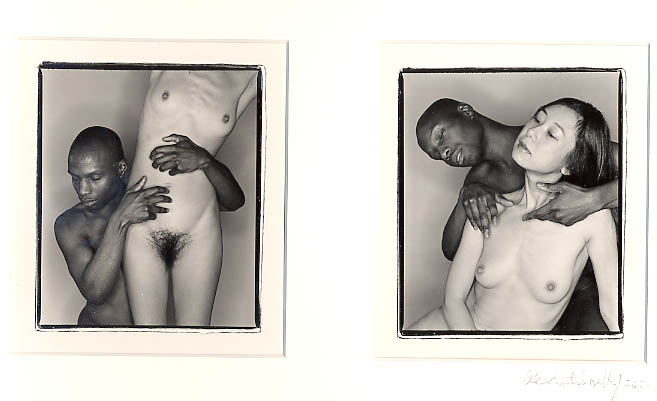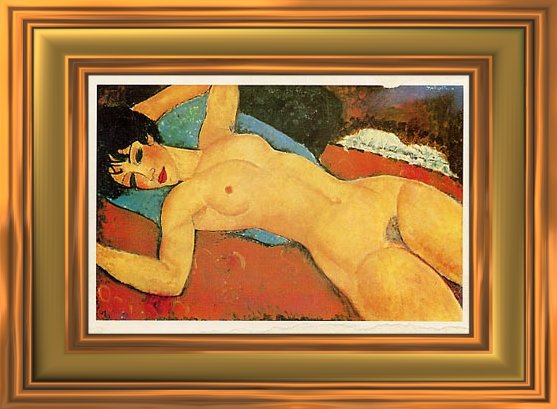The envelope
addressed to me in elegant handwriting arrived one day in 1999.
In it was a postcard of an Amedeo Modigliani nude. The postcard
was from Helen Yagi, a shy woman of few words who believes in
unconventional methods to communicate her wishes.
Mom's Kimono, photograph from a polyptych of six, 1999
 |
I decided I wanted this elegant
and graceful woman as my photographic subject. I had first noticed
Helen at gallery openings. The tacky technique of handing out
a photographer's business card was anathema. On June 2, 1998,
when Helen was interim publicist of the Vancouver Art Gallery,
I sent her a letter expressing my desire to photograph her
undraped. I first heard this soft and quaint euphemism for the
word nude during a stint at teaching photography at the Emily Carr
Institute of Art and Design.
Her brief
but affirmative reply would lead to a most fruitful photographic
relationship. Along the way I would discover the joys of pinhole
camera photography, discern what lies beneath a kimono, and
discover why Modigliani's models had long necks.
During our
first project I decided to test the untried (for me) technique
of taking nudes with a pinhole camera. We did this during a
hot summer day. Exposures were 1 minute 15 seconds and Helen
had to be very still. The only noise, my studio fan, made it
seem even longer but the results convinced me, that with very
little direction Helen was a photographer's dream subject.
Pinholes in Paradise, photographs from a polyptych of five, 1998
|
|
|
The pinhole
project led to many others.
El Piano de Cola, photographs from a polyptych of five, 2000
 |
In one I photographed her
with a friend, a pianist. Helen simply asked, "I have this
friend who plays the piano. Could we incorporate him into one
of our sessions? I could be the piano."
In another
she economically hinted, "Rita is my shiatsu therapist.
You could. . . " Rita applied the relevant pressure points
and my ring light brought startling surgical-like results.
Retouching Helen, photograph, 2000
 |
In one of
the "better" rooms of the seedy Vancouver Marble Arch
Hotel we completed two mutually very satisfying sessions. In
the first, Helen posed with a blond wig and in the other we
chose poses from several Balthus paintings. We substituted Balthus'
usual cat with a stuffed Hello Kitty.
Men's Pochy, photograph from polyptych of five, 1998
.jpg) |
Balthus, Nu Jouant avec un chat, 1949
 |
|
Count Balthazar says: "Hello Kitty", photograph from polyptych of five, 1998
.jpg) |
|
But it was
the kimono project that opened up unfamiliar territory. There
was a knock on my studio door. I opened it and there was Helen
looking as if I had been the one to have knocked on the door,
a door in Tokyo. The kimono, her mother's, was tight around
her ankles. She entered with little measured steps. During the
shoot I could not stop thinking of the privilege and my good
fortune. Item by item, I recorded the slow unlayering as Helen
explained the name, history and meaning of each divested article.
In the mid
19th century, with the advent of photography, many critics predicted
the death of 'realist' painting, thanks to the camera's ability
to capture reality. In the 21st century, thanks to Adobe Photoshop
and the airbrush technique, we can no longer trust the photograph
to deliver the truth. Meanwhile, allowing for the influence
of both of those seminal developments, artists, in some cases
unconsciously, have been adopting the photographer's methods
and techniques - to great effect. I have observed deep blue
polarized skies in the contemporary realist paintings of Christopher
Pratt and wide-angle and fish-eye lens type of distortion in
the whimsical paintings of Vancouver's Michael Abraham.
Most of
us know that objects closer to us will appear bigger. When we
point a camera with a wide-angle lens at a friend's face our
brain corrects the largeness of the nose but the camera's take
on reality remains true because a nose that is really close
will indeed appear really big. If you look at Vincent Van Gogh's
paintings of wicker chairs such as Vincent's Bedroom in Arles
and Vincent's Chair with his Pipe you would swear he
looked at them through 28mm wide-angle lens.
When Helen's
Modigliani postcard arrived I knew it was a gentle command in
the direction of our next project. I took advantage of the opportunity
to confirm a suspicion. I posed Helen in my studio and within
minutes I shot a color Polaroid and immediately converted it
into a transfer on the other side of the postcard. My camera's
wide-angle lens combined with my close proximity to the reclining
Helen created a picture that strongly resembled Modigliani's
Sleeping Nude with Arms Open (Red Nude), 1917.
Amedeo Modigliani, Red Nude, 1917
 |
|
Modiglianíssimo, photograph, 1998
 |
|

As a photographer
I suspect that Van Gogh and Modigliani are but two of many artists
whose works, often regarded as distorted, (all kinds of physical
or mental aberrations are reckoned as explanations) reflect
the accuracy of the camera. I further determined that Modigliani
was indeed physically very close (no more than half a meter
away) to his models.
I cannot
look at Modigiani's work without wondering what kind of relationship
he may have had with his models or why he chose not to show
what hid behind their eyes. Remembering Helen's unsettling gray
eyes as she lay on the couch, not a half a meter away, I think
I may have an inkling.
Editor's
note: To find more about the artist or to get in touch with
him, please write to contact@artsandopinion.com
to the attention of Marissa Consiglieri de Chackal - Arts Editor.